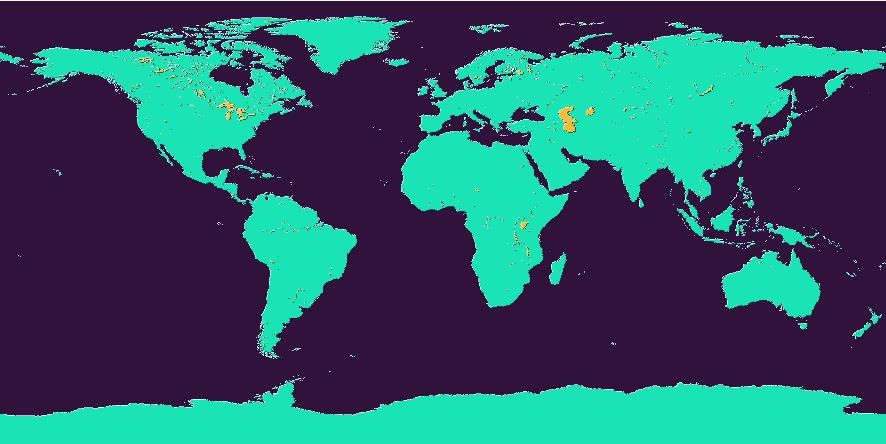pygmt.datasets.load_earth_mask
- pygmt.datasets.load_earth_mask(resolution='01d', region=None, registration='gridline')[source]
Load the GSHHG Earth mask dataset in various resolutions.

GSHHG Earth mask dataset.
The grids are downloaded to a user data directory (usually
~/.gmt/server/earth/earth_mask/) the first time you invoke this function. Afterwards, it will load the grid from the data directory. So you’ll need an internet connection the first time around.These grids can also be accessed by passing in the file name @earth_mask_res[_reg] to any grid processing function or plotting method. res is the grid resolution (see below), and reg is the grid registration type (p for pixel registration or g for gridline registration).
Refer to https://www.generic-mapping-tools.org/remote-datasets/earth-mask.html for more details about available datasets, including version information and references.
- Parameters:
resolution (
Literal['01d','30m','20m','15m','10m','06m','05m','04m','03m','02m','01m','30s','15s'], default:'01d') – The grid resolution. The suffixd,m, andsstand for arc-degrees, arc-minutes, and arc-seconds.region (
Sequence[float] |str|None, default:None) – The subregion of the grid to load, in the form of a sequence [xmin, xmax, ymin, ymax] or an ISO country code.registration (
Literal['gridline','pixel'], default:'gridline') – Grid registration type. Either"pixel"for pixel registration or"gridline"for gridline registration.
- Return type:
- Returns:
grid – The Earth mask grid. Coordinates are latitude and longitude in degrees. The node values in the mask grids are all in the 0-4 range and reflect different surface types:
0: Oceanic areas beyond the shoreline
1: Land areas inside the shoreline
2: Lakes inside the land areas
3: Islands in lakes in the land areas
4: Smaller lakes in islands that are found within lakes inside the land area
Note
The registration and coordinate system type of the returned
xarray.DataArraygrid can be accessed via the GMT accessors (i.e.,grid.gmt.registrationandgrid.gmt.gtyperespectively). However, these properties may be lost after specific grid operations (such as slicing) and will need to be manually set before passing the grid to any PyGMT data processing or plotting functions. Refer topygmt.GMTDataArrayAccessorfor detailed explanations and workarounds.Examples
>>> from pygmt.datasets import load_earth_mask >>> # load the default grid (gridline-registered 1 arc-degree grid) >>> grid = load_earth_mask() >>> # location (120°E, 50°N) is in land area (1) >>> grid.sel(lon=120, lat=50).values array(1, dtype=int8) >>> # location (170°E, 50°N) is in oceanic area (0) >>> grid.sel(lon=170, lat=50).values array(0, dtype=int8)